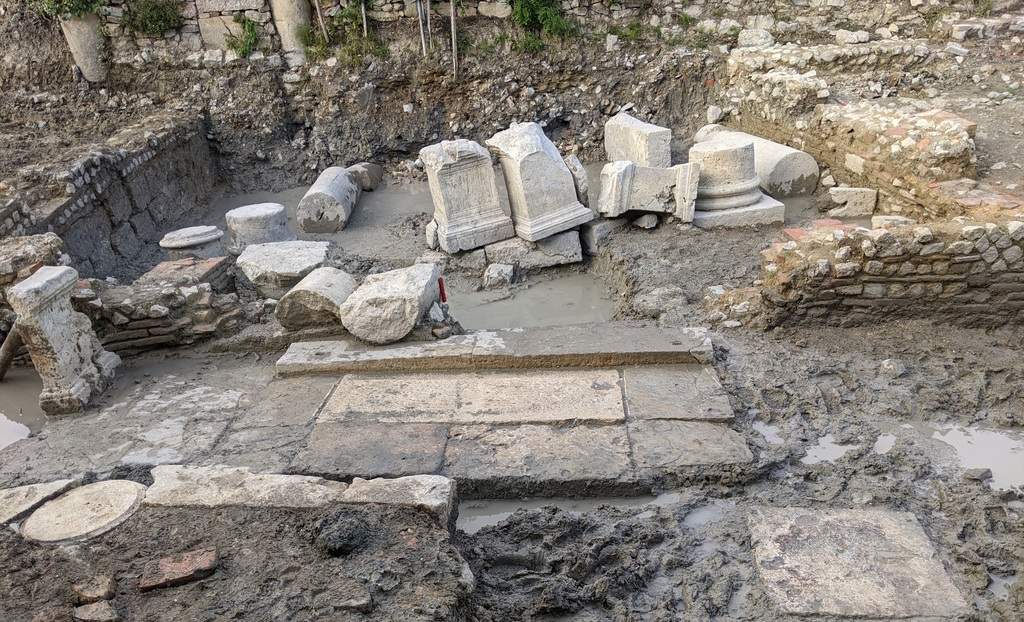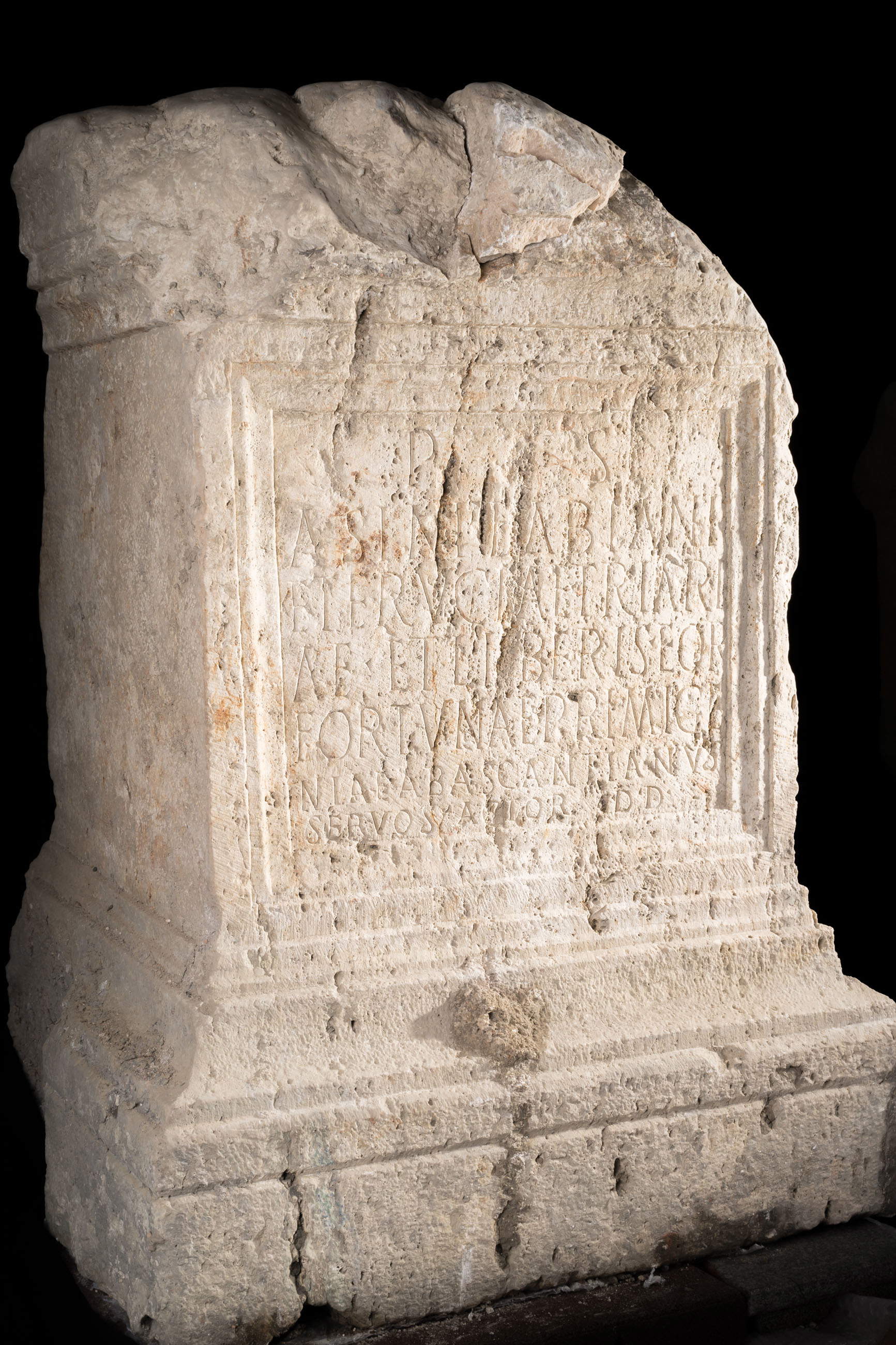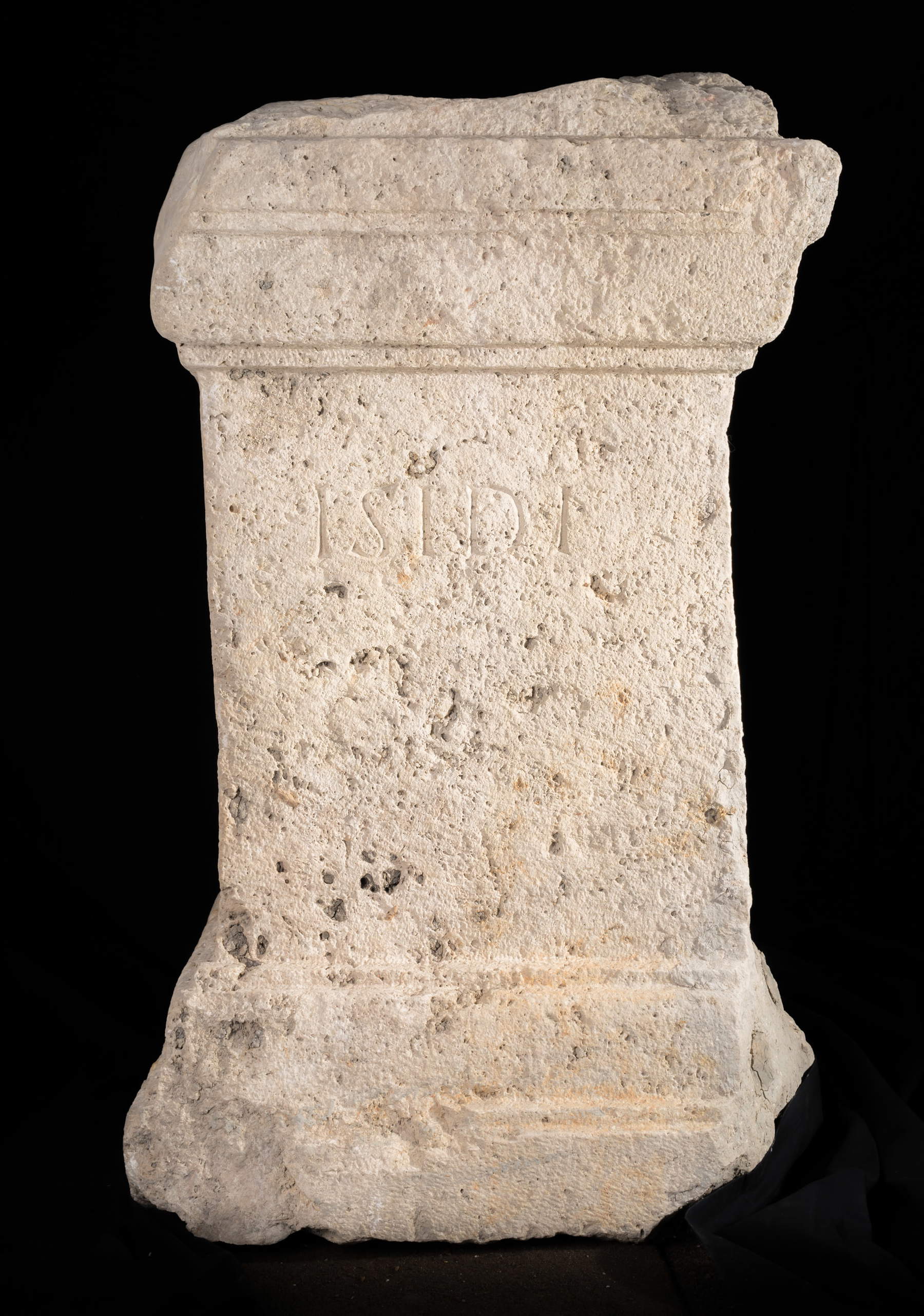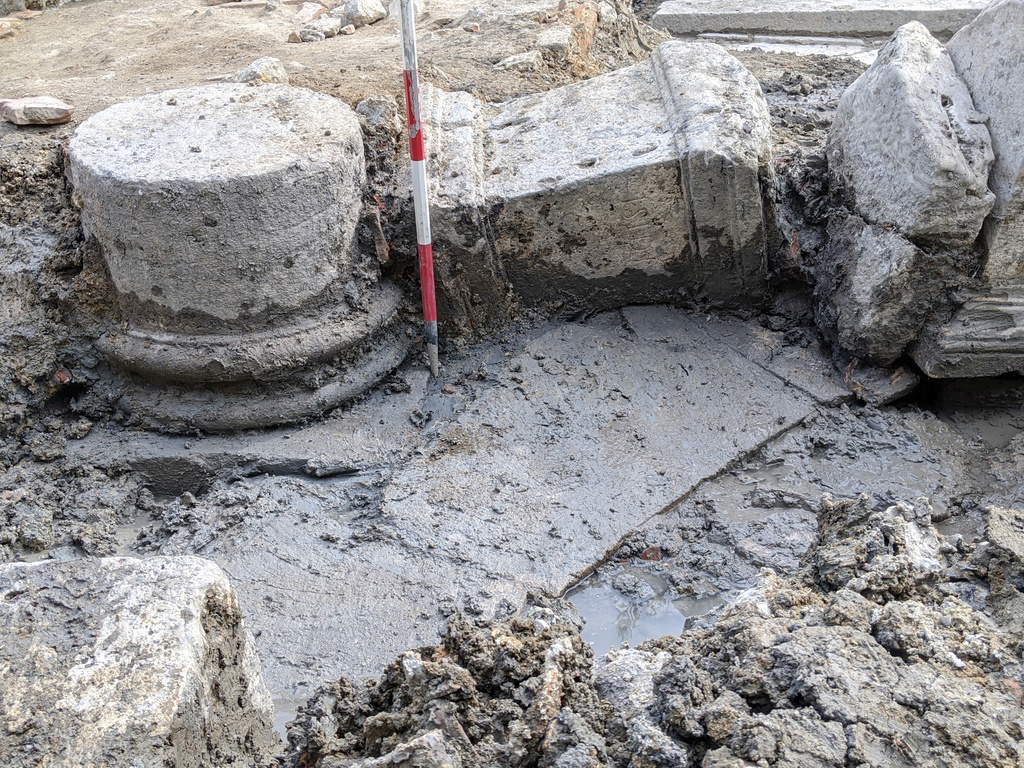Important archaeological finds at the excavation of Bagno Grande in San Casciano dei Bagni (Siena): as early as last August, traces of the monumental entrance to a Roman sanctuary had surfaced from the mud of the bath, and, abandoned on the threshold, a travertine altar had been found. The inscription “sacred to Apollo” left no doubt about the sanctuary’s tutelary deity. With the fall resumption of excavations, despite the difficulties due to the fact that archaeologists had to work immersed in hot water given the nature of the site, and of course with all the limitations imposed by the COVID-19 pandemic response protocol, the Roman Baths Project team saw reappear in the stratigraphic excavation of an abandoned kitchen garden just a few meters from the public baths still in use today, the vestiges of an excellently preserved Roman sanctuary, whose sacred character was sealed by altars dedicated to Fortuna Primigenia, Isis as well as Apollo, and a marble statue depicting Hygieia, which the young archaeologists of the excavationteam (students from several Italian and international universities, from Siena, Pisa, Florence, Rome La Sapienza, Sassari, Dublin and Cyprus) touched before they even saw clearly emerge from the hot mud.
In just two months of excavation, part of the life sequence of the cult site has emerged with clarity. The monumental layout of the sanctuary can be traced to the Augustan age: it is a structure built on a sacred site in Etruscan times at least during Hellenism. In the Augustan age the sanctuary takes the form of a compluvium-roofed building on a circular central basin, resting on four Tuscanic columns, and with a southern entrance propylaeum bordered by two Attic-based columns. Following a fire that probably occurred in the mid-1st century AD, between the Flavian and Trajanic ages the building was rebuilt and enlarged. Toward the end of the 2nd century AD three travertine altars with dedications also to Fortuna Primigenia and Isis are laid in the heart of the sanctuary, on the edge of the hot spring pool, which gushes out at 42°. A Bath indeed Great since in one place it housed so many different deities together.
The archaeological excavation is in concession to the Municipality of San Casciano dei Bagni by the Directorate General of Archaeology, Fine Arts and Landscape of the Ministry of Culture and was conceived from the beginning as a research and protection collaboration between the Municipality and the Superintendence of Siena, Grosseto and Arezzo. The Direction of the Excavation is entrusted to Emanuele Mariotti, an archaeologist who is an expert in topography and geophysics applied to archaeology, and the Coordination of the Scientific Committee is by Jacopo Tabolli, an official of the Superintendence and an adjunct professor at the University for Foreigners of Siena. The Scientific Committee also involves Stefano Camporeale (University of Siena), Paraskevi Christodoulou (University of Cyprus), Hazel Dodge (Trinity College Dublin) and Lisa Rosselli (University of Pisa). The relevant discoveries at San Casciano dei Bagni will be presented in a volume entitled The Sanctuary Rediscovered. Nuovi Scavi e Ricerche al Bagno Grande di San Casciano dei Bagni, published by Sillabe publishing house, edited by Emanuele Mariotti and Jacopo Tabolli. The volume, 272 pages in Italian with chapters in English, collects the studies of more than thirty authors on the results of the excavation at Bagno Grande.
 |
| The Roman sanctuary discovered at San Casciano dei Bagni. |
 |
| The altar of Apollo |
 |
| The altar of Fortuna Primigenia |
 |
| The altar of Isis |
 |
| The discovery of the altar of Isis |
 |
| What the sanctuary must have looked like |
“That of bringing back to light the ancient baths of San Casciano dei Bagni,” says the mayor of San Casciano dei Bagni, Agnese Carletti, “has been the greatest dream of the Municipal Administrations of the last fifteen years. After years of studies, non-invasive investigations, and the drafting of archaeological and landscape maps of the area, in August 2020 the exciting discovery of the altar dedicated to Apollo on the very last day of the excavation campaign, despite the fact that the biggest health emergency of the last century was underway, opened the door to a new era for San Casciano and the entire surrounding area. The subsequent discoveries, between last September and October, have done nothing but demonstrate that what we are accomplishing is something unique and extraordinary: we are really bringing back to a new splendor an ancient sanctuary within the Roman baths, those that over the centuries have made San Casciano dei Bagni great and that now offer us a new possibility for growth, cultural first of all, but not only. All this is a source of great pride. And it is also a source of pride to have managed to do it in a short time, because the awareness that guides us in this undertaking is that the archaeological wealth will not only have to be discovered and studied but made usable. The hope is that this whole exciting journey will be increasingly appreciated and understood so that we can continue with the excavation work as a large team composed, as it has been so far, of institutions and citizens working together for a common goal. The team that has been created in the last period is, in fact, the other great source of satisfaction with this project.”
“One of the greatest regrets we feel in this historical phase of contagions and restrictions,” says Superintendent Andrea Muzzi, “is surely that of not being able to live with fullness of meetings and initiatives the satisfaction of a work that has borne fruit beyond what could have been imagined. The discovery of the structures of a sanctuary in the enchanted territory of San Casciano dei Bagni, a name that immediately evokes customs and rituals rooted in time, took place in a complex phase for the country and for the Superintendency operating in the province of Siena, tried by shortages of personnel and resources. But the fine result achieved demonstrates, if any were needed, how many possibilities our archaeologists still have at their disposal and how much the world of field research can offer. Over the past year, targeted excavation activities, concluded less than five months ago and directed by Jacopo Tabolli and Emanuele Mariotti, have brought to light not just mere fragments but extremely rich remains of what appears, not least because of the discovery of altars and a small marble simulacrum, to be a shrine dedicated to Apollo, Fortuna Primigenia and Isis: specialists have presented in this volume their observations and studies illustrating a scenario that in the eyes of an art historian, however, is well reminiscent of a scene composed by Piranesi last year was the tricentenary of his birth with those original graphic and architectural creations of his arranged around refined inscriptions and fragments of architecture, gently placed one against the other, as an authentic, though unanticipated, ongoing reflection on time, edacious yes but allowing once again to recover material documents of considerable fascination. The discovery took place in a focal point of the municipal territory, and certainly the challenge will be, for all the institutions involved, from the Municipality, to the Universities and the Ministry itself, in being able to present and preserve it all in such a way that so many people, led here for the scenic beauty of these lands, may discover themselves interested in the many, and new I might add, archaeological riches.”
“The idea that looks at the rediscovery of the ancient Sancascianesi baths,” explains excavation director Emanuele Mariotti, “comes from afar and has seen, over the past 10 years, the alternation of various initiatives. Since 2018, the project has become more structured and has defined its archaeological, historical, landscape and topographical objectives. The area of Bagno Grande became the center of multidisciplinary activities aimed at the non-invasive investigation of the terrain and the identification of possible excavation areas that could give substance to the tradition of great finds of which the pages of local historians have been full since the 16th century. In this regard, extensive use was made of the most modern and effective remote sensing technologies, such as state-of-the-art geophysics and special drone-mounted sensors. A promising excavation area, adjacent to the modern tanks, was identified in 2020. The excavation was also the occasion for intensive training activities aimed at students and residents, aimed not only at ground investigation techniques, but also at the documentation of archaeological evidence, the first step for subsequent valorization and conservation. To this must be added the continuous confrontation with scholars who agreed to take part in the publication, a confrontation that allowed the fruitful study of the materials found, as well as being an additional training element of the highest quality. The exceptional artifacts wrested from the mud and the monumental structures brought to light are lucky finds, in themselves, very rare, but not accidental: they are the fruit of the constant work done in research and study of the area. In full agreement between the institutions involved, that synthesis between protection and research has thus been achieved, which will be the real driving force of the coming years.”
“To fully publish an excavation less than six months after its completion,” comments archaeological officer Jacopo Tabolli, “is a rather rare feat. What animated this project was the desire to share with the scientific community, with colleagues in charge of protection and enhancement, and with the public interested in archaeology the first results of an excavation that we are sure will also return important traces of the Roman religious landscape of the area in the coming years. The volume starts from the excavation of Bagno Grande but ranges in its narrative from the prehistory of Mount Cetona, to the development of the Etruscan city of Chiusi to the Romanization of the territory. That of San Casciano dei Bagni is a territory more unknown to archaeologists than so many well-known places in the Val di Chiana, Val di Paglia and Val d’Orcia, yet in the pages of the volume unfolds a tale rich in archaeological evidence, yet to be written.”
 |
| Notable archaeological discovery in Tuscany: a Roman sanctuary resurfaces in San Casciano dei Bagni |
Warning: the translation into English of the original Italian article was created using automatic tools. We undertake to review all articles, but we do not guarantee the total absence of inaccuracies in the translation due to the program. You can find the original by clicking on the ITA button. If you find any mistake,please contact us.